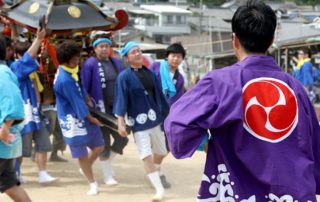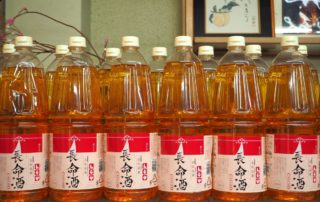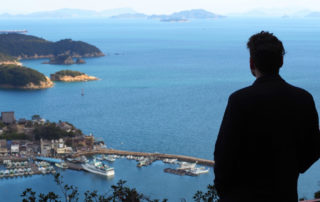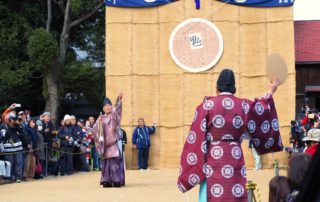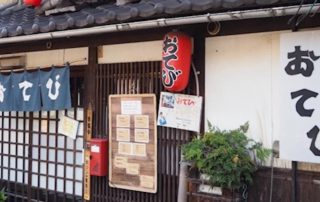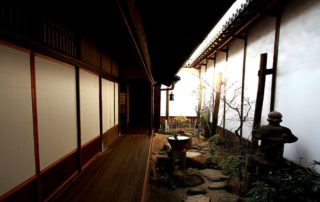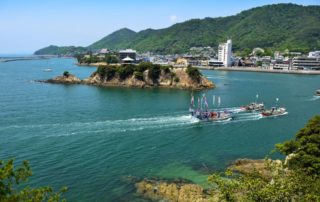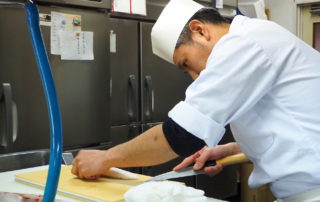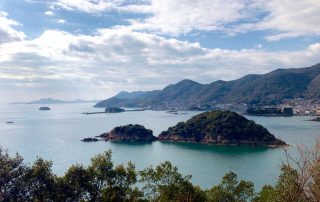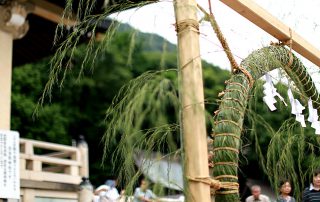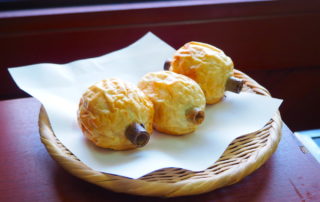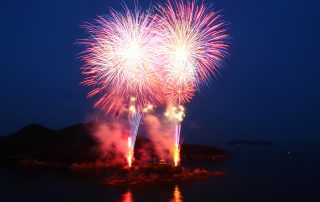MORE
Kitchen NATTY – A Cozy Beachside Café
While Tomonoura is known for its seaside views, that doesn’t always equate to beach time. Most of the Setouchi Coast is rugged and rocky. These shores are beautiful in their own way, with dramatic cliffs and dynamic rock formations making up the bulk of the region, but white sand beaches they > MORE
“Tomo-cho, Fukuyama City Preservation District for Groups of Historic Buildings” – Preserved harbor town, still just a shadow of its former self
There are 284 historic buildings built during Edo and Meiji Period until Showa Period before WWII preserved around Nishimachi area located on the southern part of Tomonoura. > MORE
“Togyo-sai Festival and Kangyo-sai Festival (Yodohime Shrine annual festival・Dango festival)” where we can witness the rolling Mikoshi being thrown away!
The annual festival of Yodohime Shrine, the Togyo and Kangyo Festival, is held on the first Saturday and Sunday in August. This festival is also called “Dango (dumpling) Festival.” This is because families in Hira region, where the shrine is located, used to make dumplings on the day before the festival > MORE
“Teramachi Street” lined with temples to protect the castle town
Something you may find surprising when looking at Tomonoura’s sightseeing map, is just how many shrines and temples there are. 19 temples and dozens of shrines are dotted around this small town. > MORE
“Iroha-maru Tenjikan” – Following Edo-era hero Ryoma Sakamoto’s footsteps in Tomo
Iroha-maru Tenjikan (Iroha Maru Exhibition Hall) is beautiful warehouse with stunning white walls located at the port near Jōyatō (all-night street lamp). It was renovated from a warehouse from the Edo period. > MORE
Filming Location Route to Discover the Scene Locations from Films and Animes
Tomonoura has been used for filming countless movies and TV dramas. Here’s a route to visit filming locations of many recently made movies and animes. > MORE
Tomo-Ryoma route – follow in the footsteps of samurai hero, Ryoma Sakamoto
Ryoma Sakamoto, a Japanese samurai in the late Edo period, was a key figure in bringing about the Meiji Restoration of 1868. He was first brought to Tomonoura as a result of the Irohamaru incident and stayed for few days, hiding his identity. > MORE
Taste the flavorful “Aka Taru Houmei Liquor”, good for health!
Established in 1908, this Houmei Liquor’s brewery “Hatta Homeishu Liquor Shop” focus on “Houmei for health”, producing it by 16 kinds of grass roots fully such as ginseng, cinnamon, dried citrus peel, chrysanthemum, yam licorice, saffron, Chinese wolfberry fruit, Solomon’s seal, clove, and so on. > MORE
Tomonoura Historic Route: Visiting the Port of Shiomachi and Spectacular Vista Points
Tomonoura prospered as the port of Shiomachi (Tide Waiting) though its appearance has evolved with the changing times. Here is our recommended route to visit historic sites, shrines, and temples related to events from Tomonoura’s history. A local guide shows you around! Tomonoura history exploration route Mutsuo Yoshioka, is one of > MORE
Buttsū and Gasuten - uniquely named dishes served in fishermen’s’ town
Restaurants and inns of Tomonoura offer many dishes of local fresh seafood from Setouchi. You can easily find and enjoy dishes made with local fish. While walking around the town, you might find some dishes with unique names: Buttsū and Gasuten. > MORE
Kinugasa Mobile Fish Market – Today’s Daily Catch at Your Doorstep
Many suburban Americans will recognize the sound of an ice cream truck jingle. For those who haven’t experience the rush of excitement many children feel when they hear a mobile ice cream shop rounding the corner of their block or the satisfying first lick of a popsicle on a hot afternoon, > MORE
An Enjoyable Stroll through Tomo in Search of Unique Cafes and Goods
Stroll along the streets of the historic town of Tomonoura In the port town of Tomonoura enjoy the Edo period atmosphere along the streets with shops that have been renovated from old buildings. Here is our recommended route to enjoy strolling through town visiting the most popular locations and shops. > MORE
Iou-ji Temple – Known as a scenic spot in Tomonoura
“Iou-ji Temple” is built on the hillside, which can be reached by traversing along a narrow, sloping path and up long stairs. It was said to have been founded by the high priest Kukai in the Heian Period (794-1185). > MORE
“Tomonoura Hina Doll Festival” – The signature festival at the port in Spring
“Tomonoura Hina Doll Festival” is just one of the many annual events in Tomonoura. Hina dolls which are handed down from generation to generation are on display in 100 homes, shops, temples etc. > MORE
“Oyumi Ritual (Shinto Bow Ritual)” releasing an arrow to wish for peace and to purify the bad demons of the past
The beautiful musical accompaniments of “Nerota, Nerota”, the Suou (ceremonial dress of lower-class samurai) worn by the archer and the Eboshi (formal headwear for court nobles) all signify the beginning of the sacred bow ritual. The archer gazes at a target about 28 meters away and draws his bow. > MORE
“Abuto-Kannon Temple” A lacquer-coated Kannon-dou temple stood on a precipitous cliff
“Bandaiji-Kannon Temple”, commonly known as “Abuto-Kannon Temple” is built on the edge of Abuto cape, which is located 4 km west of Tomonoura, and is designated as Japan’s Important Cultural Property. > MORE
Sangyo Factory Tour — How to Forge a Sea Anchor
Tomonoura is most known for its historic port sites and natural coastal landscape, but the township also boasts a notable iron manufacturing and craftmanship operation. Among the many factories still operating in the town’s blacksmith district, the Sangyo Corporation is an ironworks founded in 1951 and has succeeded a company that > MORE
“Tomonoura’s Museum of History and Folklore” for a fully comprehensive guide through the history of Tomo
“Fukuyama-City Tomonoura Museum of History and Folklore” was built on the high ground of Tomo castle ruins to celebrate the 70th anniversary of the Fukuyama city system. In the hall, there is a permanent exhibition which displays not only ancient, historical documents, but also more modern texts. > MORE
“TOMONOURA de ART” – coloring traditional streets with art
Every year from late September to early October, TOMONOURA de ART, a contemporary art exhibition, is held throughout the town of Tomonoura. > MORE
“Ōta Residence” – where Tomo’s herbal Houmei-shu was born!
Tomonoura’s local specialty is, without a doubt, Houmei-shu, a Japanese herbal liquor, made with grass seeds, using a process which began back in the Edo Period. > MORE
“Yodohime Shrine” – a deity watching over the neighbors of the Hira district
Follow a narrow road in which only one car can barely squeeze through and journey past “the two-eyed signal” (a stoplight with only red and green lights). There you will see the Torii gate entrance to Yodohime shrine. > MORE
Beautiful and gallant sea beam netfishing in the sea for a great haul!
Tomonoura’s “Tourism Sea beam netfishing” is very iconic event in early summer in Tomonoura, representing the traditional fishing style “Tie up sea beam netfishing method” which was born in early Edo Period in Tomonoura, making it one of the biggest event in Tomo area. > MORE
A fine but casual Kappo restaurant “Kinugasa”
A classy building located along the seafront at the north entrance of Tomonoura. As you go through the noren (store curtain) waved by the sea breeze, a peaceful and cozy Japanese space will await you. > MORE
“Oka-kame Houmei Liquor” that keeps cherishing his old knowledge, so as continually to be acquiring new
A cozy and historical shop which was created by being moved the Nagaya gate of Fukuyama Castle. As you step in, you will be overwhelmed by the huge dragon signboard inherited from Nakamura family, the originator of the Houmei liquor brewery. Okamoto family who has been engaged in the sake industry > MORE
Sensuijima – Exploring the Trails of Tomonoura’s Island Neighbor
During my first few days in town, I repeatedly saw a ship in the style of an industrial-era black steam boat embarking from Tomonoura’s shore. It would cross the channel between the bay and Tomonoura’s famed Bentenjima Island before rounding the corner and disappearing beyond my line of sight. > MORE
A Hero – the fishermen of Tomonoura deliver the seafood of the Setouchi and hope for the future
Although the number of fishermen is decreasing in the port town of Tomonoura, they are still fishing every day. Their fishing methods vary depending on the season and they type of fish. Once a fish is caught, it is put into a container on the ship and brought immediately into the > MORE
“16 blend Houmei liquor with Tomoe mark”, appreciate for its fine taste by making homemade Koji
“Irie Toyosaburo Honten”, one of the four leading Houmei liquor breweries that inherit the Nakamura family tradition, started their business in 1886. Since then, almost every steps have been done by hand, from steamed rice to the making of rice at their breweries inTomo-cho. > MORE
Ochi Kochi — Tomonoura’s Luxurious Seaside Ryokan
While much of Tomonoura’s charm comes in the form of quaint cafes and the historic old town, it’s not a destination devoid of luxury. Ochi Kochi, a ryokan (traditional Japanese inn) on the banks of the Seto Inland Sea, promises an indulgent stay and the best in Tomonoura hospitality for overnight > MORE
Kenshoji Temple — Meditation and Monster Trucks at a Buddhist Temple
I recommend Kenshoji both for the spiritual kanjingyo meditation and for the company of its charismatic priest. Down one of the quiet back streets of Tomonoura, you’ll find the entrance to Kenshoji Temple. Dating back to the 1600s, this temple has long served practitioners of Nichiren Buddhism in the seaside town, > MORE
“Chinowa Kuguri” purifying your soul of all evil by going through a big ring
As you walk through Tomonoura, you may be lucky enough to notice a small ring hanging down, marking an entrance. This is an amulet called “Chinowa”. “Chinowa” is a ring woven by Imperata cylindrica. > MORE
Taishiden – A Setouchi Lookout Worth the Climb
A fixture on the Hiroshima coast of the Seto Inland Sea, Tomonoura for centuries was a major trading port and docking bay, most famously used as a hiding place for the famous samurai in Japan Sakamoto Ryoma. But this strategic geography has brought more than maritime commerce and famous rebels to > MORE
“Otebi Ritual” – Wish for good health and ward off evil with a big burning torch!
Tomonoura’s Otebi Festival is held in the evening before the second Sunday in July, where the town of Tomonoura is transformed into a sea of fiery reds. The Otebi Shrine Ritual is a purified ritual that takes place on June 4th in the old calendar before the Mikoshi Togyo of Susano > MORE
Tomonoura Nightlife — Italian and Spanish Cuisine After Sunset
Any trip to Tomonoura should include a stop by the historic Tomo Port at sunset. Orange and red hues reflect off the waters of the Seto Inland Sea, casting the docking bay and cobblestone streets of Tomonoura’s old town in warm light. > MORE
“16 Blend Houmei Liquor” produced in the same way as in the Edo Period
The simple bottle stamped “Bigotomozu 16 Blended Houmei Liquor” looks as if it were precious holy water or Arcanum handed down from mountain hermits. With its long history and sacred appearance, “16 Blended Houmei Liquor” produced by “Houmei Liquor Shop” can transport us back to a calm and spiritual time. > MORE
Making Chikuwa – Amochinmi’s Famous Fish Paste Cake
Chikuwa may not have name recognition overseas, but the tube-shaped fish paste cake is beloved throughout Japan and commonly made in coastal areas. Like the American hot dog, however, chikuwa is a staple that is widely consumed but not well understood, or at the very least bought commercially and not considered > MORE
“Fukuyama Tomonoura Bentenjima Fireworks Festival” – A special event celebrating the arrival of summer
The last Saturday of May, in the midst of the Tomonoura Kankō Taiami (a traditional event of sea bream fishing using a net), the Fukuyama Tomonoura Bentenjima Fireworks Festival is held, a special event celebrating the arrival of summer to the Setouchi. > MORE
Taichou-rou – Stunning Scenery and Sutra Calligraphy at Fukuzen-ji Temple
I took to me knees on the tatami mat of Fukuzen-ji, the wooden beams of this centuries-old temple framing a postcard worthy scene. In the foreground was Bentenjima Island, a rocky islet with a pagoda spire ascending above the tree line. Beyond was the rolling greenery of Sensuijima Island. > MORE
Ryoma was hidden in the attic!? “Ryoma’s hideout”
The“Masuya”residence was once home to a shipping agent who dealt in providing not only accommodation but also supplies for various clans at Tomonoura in the Edo Period. It is here that famous samurai “Ryoma Sakamoto”stayed in hiding in the secret attic room found only after his death. > MORE
“Nunakuma Shrine” a little Gion protecting the town and the sea of Tomonoura
Nunakuma Shrine is Tomonoura’s representative shrine, so locals call it “Gion-san” or “Gyon-san”. In the Meiji Period, “Watasu Shrine” where Oowatatsumi no Mikoto, a deity of the sea, was enshrined was integrated with “Gion sha” where Susano no Mikoto, one of the three important deities, was enshrined. It soon became a > MORE
“Tomonoura Sakura Group Home” – Supporting the elderly population in their everyday lives
Although it is a calm and peaceful port town, Tomonoura faces serious challenges in decreasing population and an aging population. Based on these needs in the community, Tomonoura Sakura Group Home supports the elderly > MORE
Feel the power of nature! “Goshiki-iwa Rock” – the shore wall in blue, red, yellow, white and black
Sensuijima Island, situated off Tomonoura town, was designated as one of the majestic scenic spots in “Tomo Park” along with the neighboring Tsutsuji-jima Island, Kogo Island, Benten Island, Tamatsu Island and Tsugaru Island in 1925. > MORE
Tomonoura Kayaking – A Setouchi Adventure at Sea
There are plenty of ways to enjoy the seaside beauty of Tomonoura’s port town, and while each has its own merits, if I was to recommend just one, I would recommend a sea kayaking tour. Why settle for views of the Seto Inland Sea from the shoreline when you can enjoy > MORE
Tomo Shiomachi Minitruck Market – A Sunday Showcase of Fukuyama Products
On a cold January morning, there are few things that bring people out of their heated homes and out onto the streets of Tomonoura. Tomo Shiomachi Minitruck Market happens to one of the few exceptions. Since 2011, the minitruck market has been held on the grounds of Nunakuma Shrine on the > MORE
Hiraishoten – Homecooked Oden (Japanese Stew) in a Retro Market
As a Tokyo resident, I’ll routinely pass half a dozen convenience stores on the walk to my nearest train station: one Family Mart, then a Lawson, then another Family Mart, then a 7-11 for good measure. The convenience is undeniable, but passing this chain of chain stores, > MORE
Watch a small port town come alive at the famous 3-day-long Autumn Festival
Autumn is the busiest season in Tomonoura port town as everyone anticipates the big Autumn Festival. The autumn festival is an annual festival held at “Watasu Shrine”, a supplementary shrine to “Nunakuma Shrine”, from August 11th of the lunar calendar for three days (currently in the middle of September from Friday > MORE
History Exploration Route to Enjoy Strolling Around the Historic Sites of Tomonoura
Tomonoura still has a strong sense of history as a port town that prospered in the past, with port facilities from the Edo period that are nearly perfectly preserved. Check out our recommended route for strolling around the historic areas of Tomonoura, envisioning its glorious past. > MORE





